
The First Spacewalk
How the first human to take steps in outer space nearly didn't return to Earth
Alexei Leonov did not feel as if he was in motion as he clambered on to the outside of the spacecraft, 500km above the Earth.
But in reality, he was hurtling around our planet at speeds that are many times faster than a jet aircraft.
The vast, vivid geography of our planet stretched out before him - a giant canvas of contrasting colours and textures.
He was the first of his species to see our planet in such glorious aspect. The Russian was quickly overwhelmed:
You just can't comprehend it. Only out there can you feel the greatness - the huge size of all that surrounds us.”
News of the first ever spacewalk on 18 March 1965 was received with shock and delight. It took place against a battle for supremacy in space between the US and the USSR.
The Voskhod 2 mission was hailed as a propaganda coup for the Soviet Union and as a blow to American pride.
But this triumphant narrative bore little resemblance to what actually took place behind the scenes.
Leonov, now 80, has given a rare interview to the BBC in which he talks about the series of emergencies that made the trek back to Earth worthy of any Hollywood movie.
Minutes after he stepped into space, Leonov realised his suit had inflated like a balloon, preventing him from getting back inside.
Later on, the cosmonauts narrowly avoided being obliterated in a huge fireball when oxygen levels soared inside the craft.
And on the way back to Earth, the crew was exposed to enormous G-forces, landing hundreds of kilometres off target in a remote corner of Siberia populated by wolves and bears.
Afterwards, the Soviet authorities revealed nothing about the problems. For years, few people knew the truth.
This was not unusual. America’s successes and failures took place in the full glare of public attention. But the Soviets were obsessive about controlling the message through secrecy and censorship.
Alexei Leonov (top left) with other Vostok and Voskhod crew members
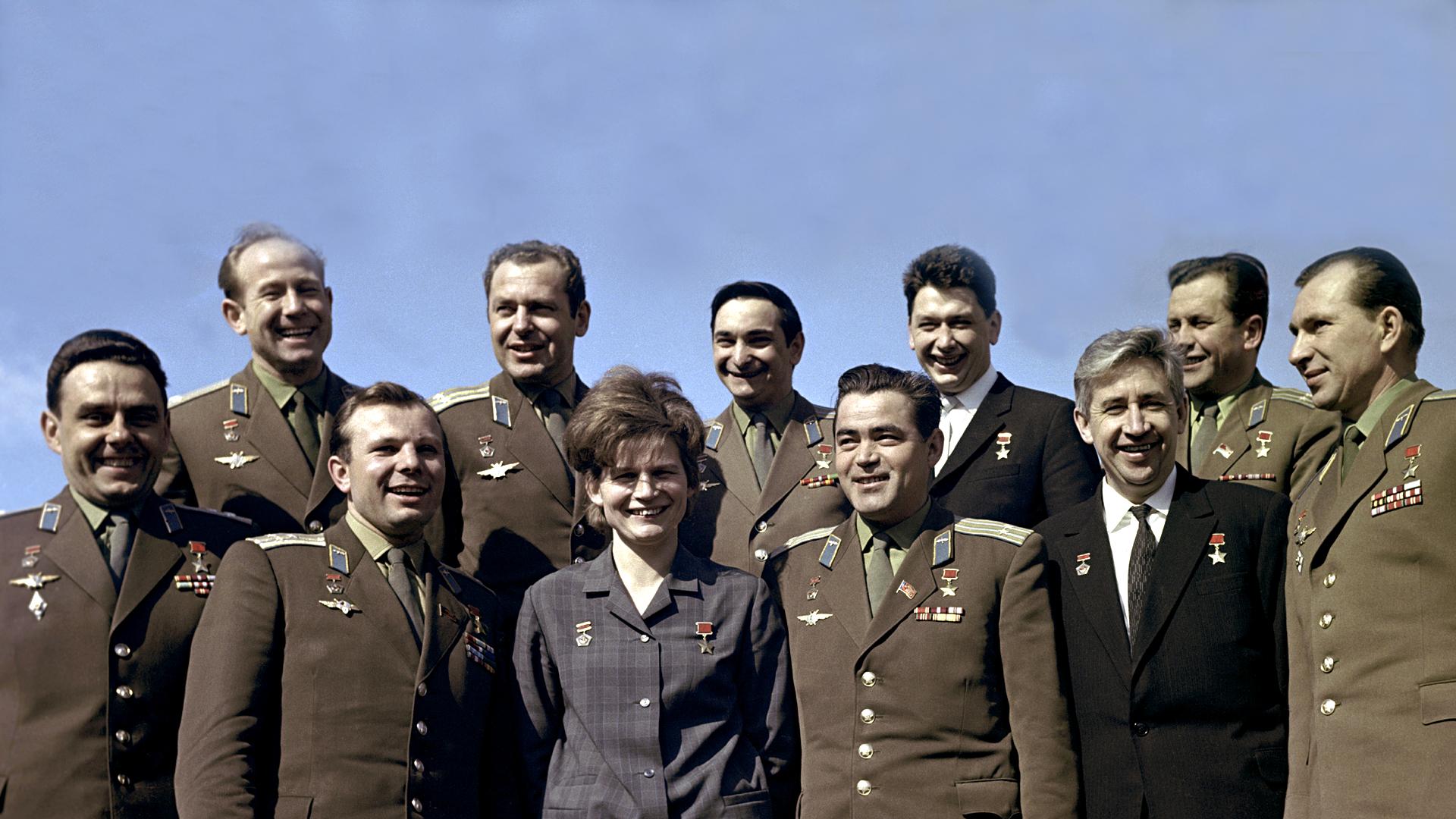
Alexei Leonov was born in 1934 in the tiny village of Listvyanka in Central Siberia. He was three when his father was wrongly imprisoned without trial during one of Joseph Stalin’s infamous purges.
The Leonovs were labelled subversives and neighbours were encouraged to ransack their home.
But Alexei brushed aside this tough start. He showed a early talent for art, but ended up graduating as a fighter pilot by his early twenties.
Not long after graduating, he was invited to compete for the opportunity to go into space.
He was successful, and joined the original class of 20 cosmonauts alongside Yuri Gagarin, who was to become the first man in space in April 1961.
At this stage, no one knew how the human body would respond to being in outer space. So the cosmonauts were subjected to an intensive training regimen that tested them to their physical and mental limits. Leonov recalls:
You needed to be physically fit. Every day I ran a minimum of 5km and swam 700m.”
Ice hockey was banned after several fellow trainees were injured. It was replaced with football, volleyball and basketball.
Space travel exposed the body to high G-forces. So the trainees were spun round in centrifuges, sometimes until they passed out.
They were also locked in a sensory deprivation chamber. But the room’s oxygen-rich atmosphere made it dangerously flammable inside.
In 1961, Valentin Bondarenko accidentally dropped a piece of alcohol-soaked cotton wool on to a hot plate while training in the chamber. He was engulfed in a fireball, dying in hospital hours later from horrific injuries.
After that, engineers switched to using normal air.
In early 1963, the cosmonauts received a summons to OKB-1, the main centre in Moscow for designing and building spaceships. They were invited to visit by Sergei Korolev, the mastermind behind the USSR’s space programme.
The spacecraft looked similar to the space vessels that Gagarin and other cosmonauts had flown in. But one of them was different. It was fitted with a transparent tube about 3m long and 1.2m wide – an airlock.
As the curious cosmonauts gathered round this unusual vehicle, Korolev addressed them:
A sailor must be able to swim in the sea. Likewise, a cosmonaut must be able to swim in outer space.”
Then he singled out Leonov and told him: “You, little eagle, put on that suit.”
After watching from the sidelines for more than a year, this was the moment Alexei Leonov had been waiting for.

One step at a time
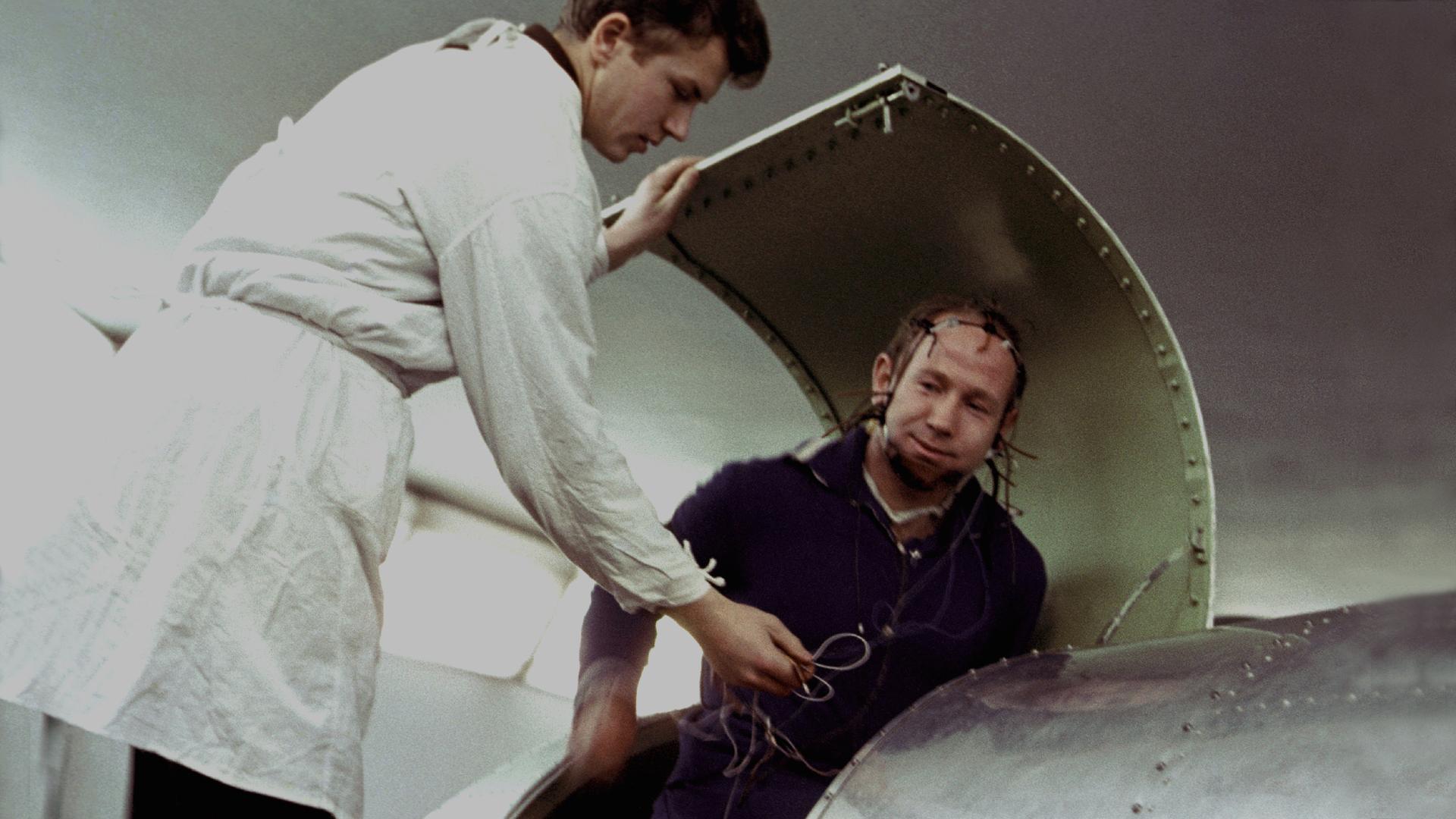
Alexei Leonov was given two hours to rehearse a spacewalk in one of the new vehicles.
After his time was up, he would have to report to Korolev with his thoughts on how best to safely exit and enter the spacecraft.
"My heart started thumping,” Leonov says. “How would I do the report?"
Leonov quickly overcame his nerves and set about the task. After the briefing concluded, Yuri Gagarin approached him outside:
I think they have selected you. You will be in charge of the spacewalk.”
The mission, named Voskhod (Sunrise) 2, required a spacewalker (also the navigator) and a commander to pilot the ship.
Leonov lobbied hard for his friend Pavel Belyayev to sit in the commander’s seat.
He got his way, despite doctors’ concerns about a leg injury Belyayev had sustained during parachute training.
Belyayev was 10 years older than Leonov and had seen action as a fighter pilot in the final days of World War II, flying sorties against Japan from Russia’s far east.
He was courageous and capable.
Alexei Leonov and Pavel Belyayev
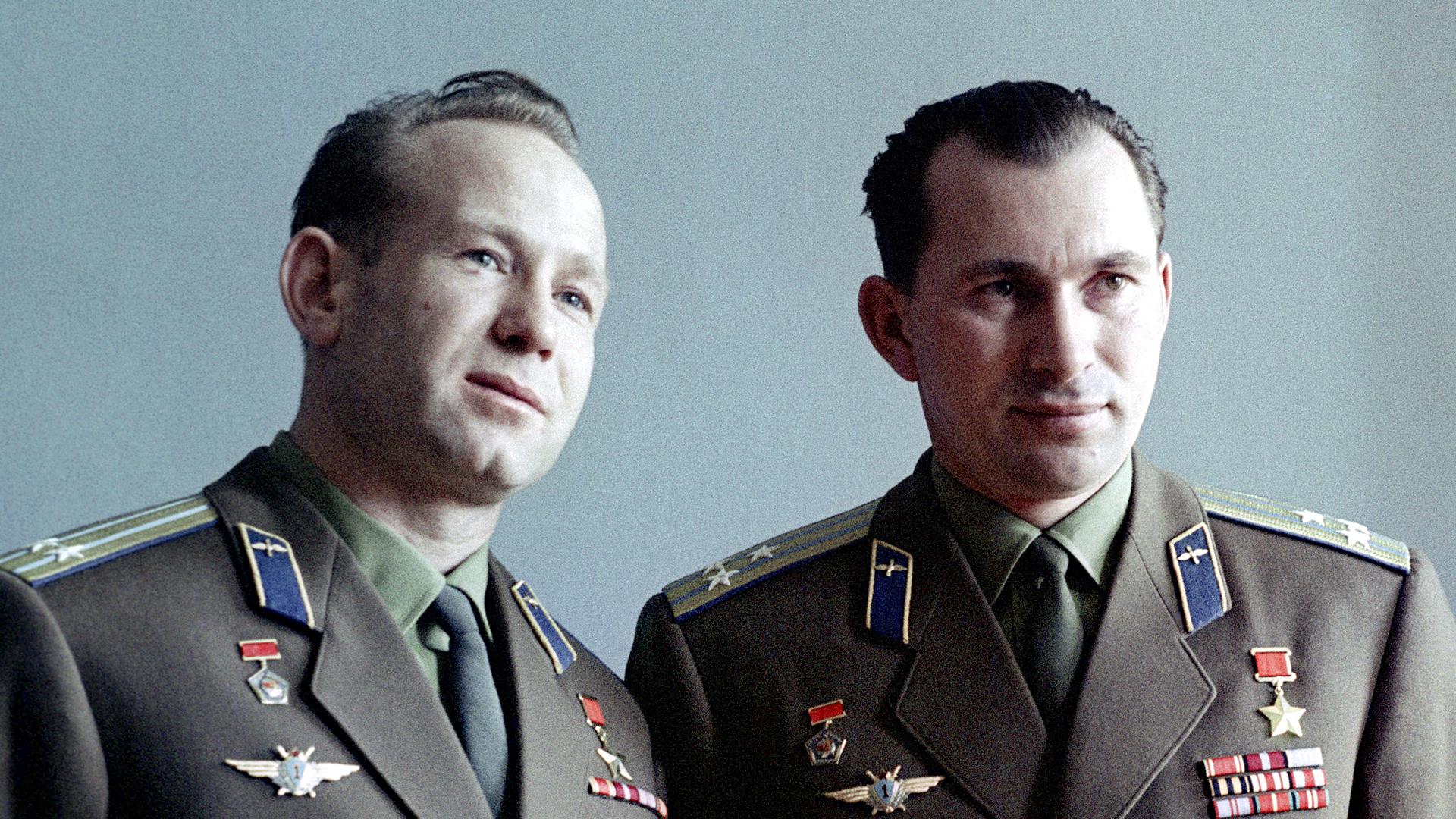
Training for the mission began in earnest.
The pair had to learn how to fly and navigate the spacecraft as well as simulate every moment of the spacewalk under weightless conditions.
This could only be done on a Tupolev-104 plane flying in a series of parabolic arcs. As the plane went over the top of the arc, the occupants experienced zero gravity for 25 seconds at a time.
The Voskhod 2 mission was put together in a tight timeframe. The Soviets were anxious to perform a spacewalk before the Americans and they knew that Nasa was preparing astronaut Ed White for the task.
Dr Asif Siddiqi, from Fordham University in New York, is critical:
The [Voskhod] ships are extremely dangerous because there's not enough safety built in, not enough redundancy. They're one-offs, almost solely for propaganda purposes, and designed to one-up the United States.”
But Georgy Grechko, a cosmonaut who flew on several Soviet space missions, says both sides were in a contest:
We did our job - it was complicated and risky. We wanted be ahead of the US, and they wanted to be ahead of us.”
“Why do you have the Olympic Games? Because someone wants to be ahead. Why do you have a World Cup?”
On the morning of 18 March 1965, the cosmonauts were woken up for their flight. They were given a medical and then observed several traditions that had developed in the years since Gagarin’s launch.
Yuri opened a bottle of champagne and poured it into glasses for the cosmonauts to sip. Then they signed the bottle, making a pledge to drink the rest on their return from space.
Afterwards, they urinated on one of the wheels of the bus used to transport them to the launch pad at Baikonur.
At 0700 GMT, the R-7 rocket’s engines ignited and propelled the two cosmonauts into the sky.
Upon reaching orbit, Belyayev deployed the airlock while Leonov strapped on his life support system. Then, with a slap on the back from Belyayev to see him off, Leonov crawled into the airlock and closed the hatch behind him.
Leonov waited patiently while Belyayev equalised the pressure in the airlock with the zero pressure in space.
This would help purge nitrogen gas from Leonov’s body, protecting him against decompression sickness, also known as “the bends”.
Eventually, the all-clear was given to open the external hatch.
As Leonov looked out at the Earth, night was turning to day, and Africa filled his field of view.
Sergey S Pozdnyakov, general director of Zvezda, which manufactures the spacesuits for Russia’s cosmonauts, says it would have been difficult to know how Leonov would react next:
“The main doubt was the psychological condition of the person who was in outer space. In the ship, you have walls, you have communications with Earth, you are protected.”
But to go into outer space… the stress is, in my opinion, so high, that to predict how a person will behave in this situation is impossible.”
Floating free
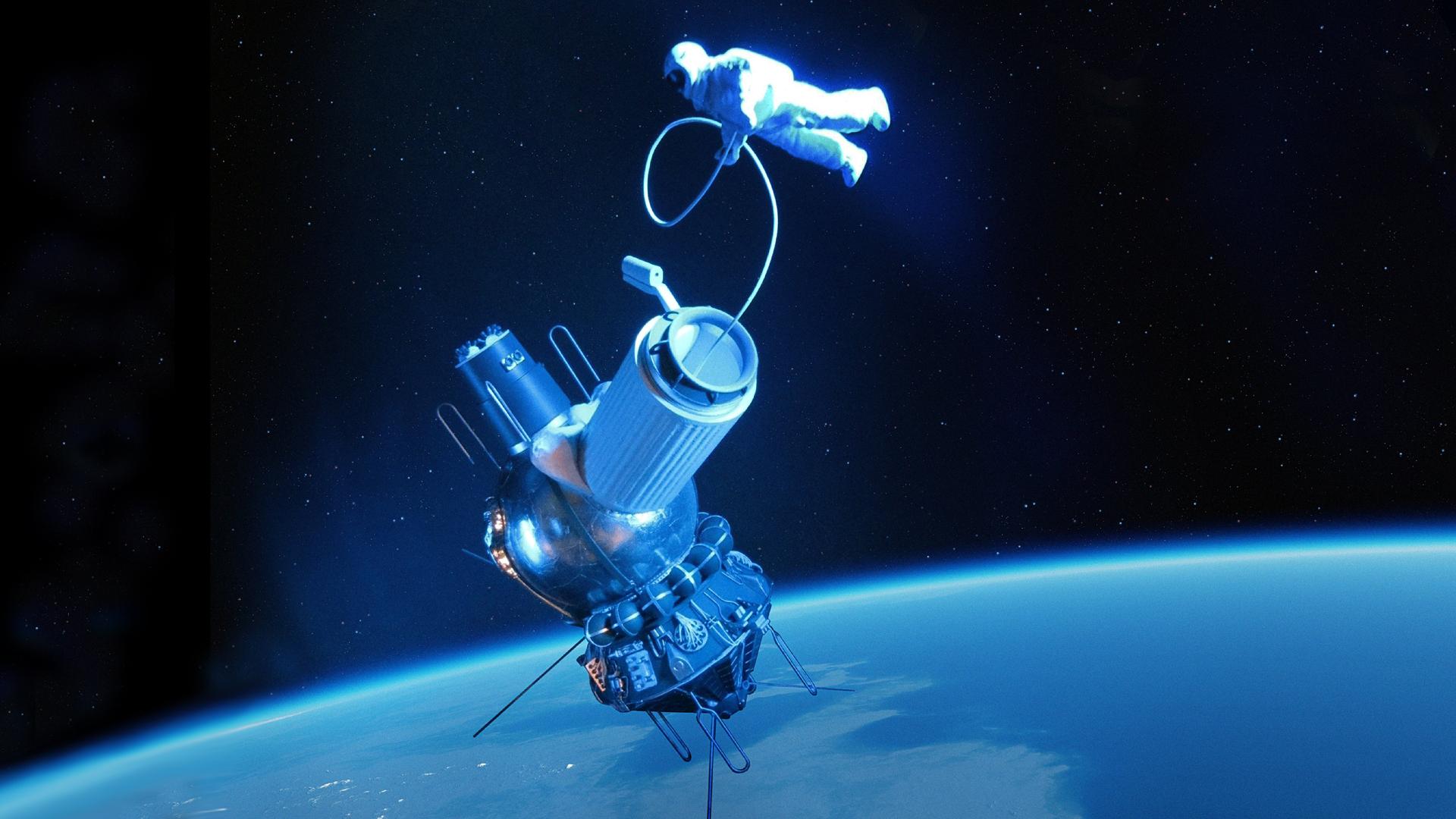
Leonov climbed on to the rim of the airlock where a movie camera would record footage of his historic step into the unknown.
To observers in space, the Earth continually seems to be turning beneath them.
In fact, both the planet turning on its axis and the movement of the spacecraft determines which parts of Earth are visible below.
From his vantage point, Leonov could now see Greece, the Balkans, the Crimea and the Baltic.
The view below him was staggering – our planet’s geography laid out in a colossal panorama.
My feeling was that I was a grain of sand.”
Leonov was tethered to the airlock with a 5m-long “umbilical cord” that prevented him from drifting into space.
The cosmonaut decided to test the limits of his movement by launching himself off the side of the spacecraft.
He immediately went into a spin, but the cord pulled him to a stop.
When Leonov got the instruction to come back inside the spacecraft, he had been outside for 10 minutes.
He’d proved that the Soviet space suit worked in open space.
Reluctantly, he prepared to return.
At this point the cosmonaut realised something was wrong. The lack of atmospheric pressure in space had slowly caused his spacesuit to inflate like a balloon. He recalls:
My suit was becoming deformed, my hands had slipped out of the gloves, my feet came out of the boots. The suit felt loose around my body. I had to do something.”
"I couldn’t pull myself back using the cord. And what’s more with this misshapen suit it would be impossible to fit through the airlock."
In five minutes he would be in the Earth’s shadow, and plunged into total darkness.
Without telling ground control, the cosmonaut decided to bleed half of the air out of his spacesuit through a valve in its lining.
This risked starving his body of oxygen, but if he couldn't get back inside the capsule, he’d be dead anyway.
Leonov let out a little oxygen at a time to reduce the pressure. But as he did so, he started to feel the first hints of decompression sickness.
"
I began to get pins and needles in my legs and hands. I was entering the danger zone, I knew this could be fatal.”
He started coiling the cord in order to haul himself back. When he finally reached the airlock, he pushed the camera in, grabbed the sides and lurched through head first.
The extreme physical exertion had caused his temperature to soar; he was now at risk of heatstroke and sweating uncontrollably. The globules filled his helmet, obscuring his vision.
Leonov was supposed to re-enter the airlock feet first.
Getting in the wrong way meant he had to turn himself around in the cramped space to make sure the umbilical cord was inside and the hatch was locked.
He says: “It was the most difficult thing: I’m in this suit and I had to turn around in the airlock. But with the perspiration, I couldn’t see anything.”
I don’t normally sweat much, but on that day I lost 6kg in weight.”
After curling around in his bulky suit, in such a narrow space, Leonov finally made it back inside the craft.
He sat back down in his seat next to Belyayev and hurriedly removed his helmet so that he could wipe his eyes.
The airlock had now served its purpose, but when the cosmonauts fired the small explosive charges to eject it into space, the kick caused the spacecraft to rotate.
The effect was disorienting for the cosmonauts, but nothing could be done to correct it.
Then they became aware of another, more serious problem. The spacecraft’s instruments showed oxygen levels steadily climbing at an alarming rate.
The loss of Valentin Bondarenko, the man who died after dropping a piece of cotton wool, had taught the Soviets a grim lesson.
As the oxygen pressure soared, Voskhod 2’s cabin became dangerously flammable.
The cosmonauts frantically worked to lower the temperature and the humidity. This halted the relentless rise in oxygen pressure, although it remained high for some time.
Eventually, the level began to fall. Leonov explains:
Fortunately the engines produced no sparks. A spark would have caused an explosion and we would have been vaporized.”
Several hours would pass before the time came for Leonov and Belyayev to prepare for their return to Earth.
But minutes before the retro-rockets were supposed to fire, kicking off the descent through the atmosphere, the spacecraft’s automatic re-entry system failed.
The men would have to fire the rockets manually – something that had never been done, and required incredible precision.
If the burn was too short, the Voskhod 2 would hit the atmosphere at too shallow an angle, bouncing back into space.
But if the burn continued for too long, it would come down at too steep an angle. This would cause it to plummet at much too high a speed - and be destroyed.
With the right burn duration, at the right time, the capsule would plunge through the atmosphere on a trajectory that would bring it down safely.
The rocket firing went well, but the cosmonauts had little control over where they would land.
The best they could hope for was that the craft would touch down somewhere in the Soviet Union’s vast landmass.
Lost in the woods
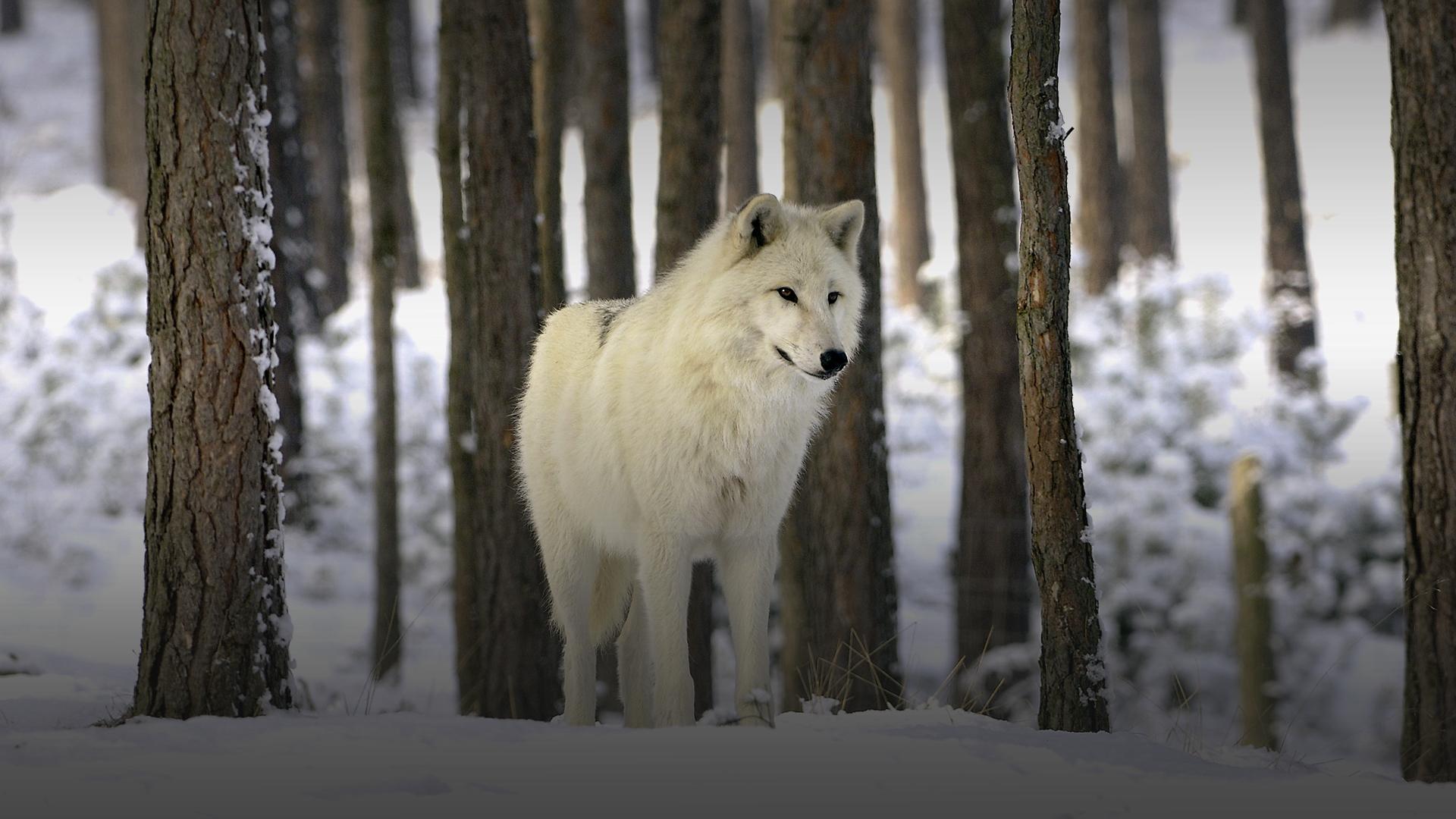
During the descent to Earth, the spacecraft’s equipment module, which contained engines and propellant, failed to fully detach as planned.
The cosmonauts were exposed to high G forces as both the equipment and descent modules of the spacecraft started tumbling.
However, the ordeal ended when the cable linking the modules burned through, freeing the cosmonauts’ capsule.
The descent module floated through the clouds on its parachute. It touched down in deepest Siberia, in the middle of a forest of birch and fir trees. Leonov recalls:
We landed and opened the hatch. The air was cold, it rushed in. We set up our radio channel and began to broadcast our coded signal.”
“Only after seven hours did a monitoring station in West Germany report that they had heard the coded signal which I had sent.”
Both cosmonauts had grown up at the forest’s edge, and understood its dangers.
It was home to wolves and bears, and March was mating season, when the animals were at their most aggressive.
After a few more hours, the cosmonauts heard the unmistakable thud of helicopter blades. They walked to a clearing, where they saw that it was a civilian chopper.
The pilot and crew were keen to rescue them, throwing down a rope ladder. But it was too flimsy for Leonov and Belyayev to climb in their heavy spacesuits. They declined the offer.
The helicopter crew must have told others of the men’s whereabouts. As other aircraft began to circle above them, crews threw all kinds of items out for the cosmonauts: a bottle of cognac - which smashed the instant it hit the snow - a blunt axe and warm clothes, most of which got caught in the branches of the tall trees.
Private aircraft were and are relatively common in Siberia, because of the vast distances to travel.
As it got dark, the cosmonauts realised they would have to wring the moisture out of their suits to avoid frostbite.
Leonov had perspired so much on the spacewalk that his sweat was now sloshing around in the suit, up to his knees.
There was no way to cover the hatch opening, so they would have to cope as best they could as temperatures dropped to -25C.
Leonov remembers that he and Belyayev awoke to the sounds of a rescue party approaching:
They landed 9km away and came on skis. They made a little hut for us and brought us a big cauldron which we filled with water and put over a fire. Then we washed in it.”
The men had to spend another night in the forest, but this time it was in the more comfortable surroundings of their new log cabin.
The next day Belyayev and Leonov donned skis for the 9km journey to a clearing where a helicopter was waiting to fly them to the city of Perm. Leonov recalls:
When we flew out of there, the rescuers said they saw wolf tracks around the spacecraft.”
“Wolves are very smart, they came to look at what had come down from the sky into their territory.”
From Perm, the men were flown back to Baikonur, where they were greeted on the runway by Korolev and Gagarin.
During a mission debrief, Leonov had to explain why he had broken protocol by venting his air into space without telling ground control.
He responded: “What would you have done if I’d told you? You would have created a commission. The commission would have selected a chairman, and the chairman would talk to me.
I knew I only had 30 minutes left and I didn’t want ground control to panic.”
Sergei Korolev, the chief space designer, backed him, saying: “Alexei is right.”
After the cosmonauts returned, the authorities said nothing to the press about the problems encountered on the mission.
It took many years for the truth to emerge about the first, historic spacewalk mission.
For years, the Soviet space programme was seen by some in the West as a less sophisticated pretender to Nasa, whose achievements in the era of the Moon landings are viewed as a high bar in the human exploration of space.
But it was the space pioneers of the Soviet Union who blazed a trail - taking risks, making mistakes but ultimately pushing the boundaries of human knowledge.
“If there are some people who think that what we did was primitive, not very interesting, not worthwhile - let them fly into space, go for a spacewalk and experience the air leaking from your suit, or a safety hatch refusing to shut,” says cosmonaut Georgy Grechko.
“Then they will understand that our pride and happiness is deserved.”



